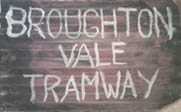 Woodhill
Mountain Structures
Woodhill
Mountain Structures Woodhill
Mountain Structures
Woodhill
Mountain Structures
Here is a detailed overview of the structures of Woodhill Mountain. Apologies for it's length and load time. Enjoy.
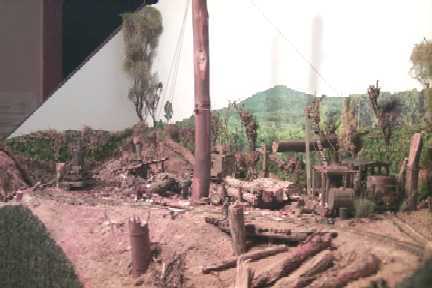 While Woodhill Mountain appears
devoid of recognizable structures such as building, it took just as much time
to plan as the Broughton Vale logging camp scene on the other side of the viewblock.
See that tall tree trunk front and centre? It is called a spar tree and was
set up by loggers with overhead pulley systems powered by a steam winch. Fitting
such a large item into a small scene takes a lot of planning. On the first plan
of Broughton Vale, the spar tree was to be located just out of shot, to the
left on an outcropping. The theory was that this would disguise the "sneak
off" track between the Woodhill Mountain and Broughton Vale scenes by making
it a log loading spur. Thankfully I was given
some good advice by Mark Fry, to the effect of, "It would be such a waste
to not put the spar tree in the centre of the scene, thus enabling it to be
modelled fully rigged and guyed". The scene above demonstrates the wisdom
of this advice. The spar tree as modelled scales out at around 80' tall, and
dominates the loading scene as did the real thing. Mark also encouaged me to
drop the front edge of the scene. Visual artists are taught that focal points
on a display need low front edges. This encourages the viewer to look "up"
from the front edge into the target scene. Conversely, a tall front edge visually
blocks off view and forces the viewer to look elsewhere. This techniques was
also used in the Broughton Creek scene, where the deep cutting forces the viewer
to look at the trestle and to move to the right to see "into" the
cutting.
While Woodhill Mountain appears
devoid of recognizable structures such as building, it took just as much time
to plan as the Broughton Vale logging camp scene on the other side of the viewblock.
See that tall tree trunk front and centre? It is called a spar tree and was
set up by loggers with overhead pulley systems powered by a steam winch. Fitting
such a large item into a small scene takes a lot of planning. On the first plan
of Broughton Vale, the spar tree was to be located just out of shot, to the
left on an outcropping. The theory was that this would disguise the "sneak
off" track between the Woodhill Mountain and Broughton Vale scenes by making
it a log loading spur. Thankfully I was given
some good advice by Mark Fry, to the effect of, "It would be such a waste
to not put the spar tree in the centre of the scene, thus enabling it to be
modelled fully rigged and guyed". The scene above demonstrates the wisdom
of this advice. The spar tree as modelled scales out at around 80' tall, and
dominates the loading scene as did the real thing. Mark also encouaged me to
drop the front edge of the scene. Visual artists are taught that focal points
on a display need low front edges. This encourages the viewer to look "up"
from the front edge into the target scene. Conversely, a tall front edge visually
blocks off view and forces the viewer to look elsewhere. This techniques was
also used in the Broughton Creek scene, where the deep cutting forces the viewer
to look at the trestle and to move to the right to see "into" the
cutting.
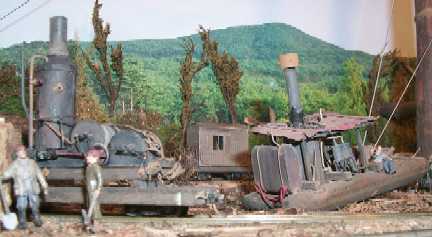 These two yarders make an interesting
pair sitting on the Woodhill Mountain scene. The smaller unit sitting on the flatcar
is based on plans published in an issue of TIMBERBEAST of Washington Iron Works
9" X 10" wideface yarder #A765. This machine was scratchbuilt to represent
it as depicted in the plans, derelict in Garabaldi, Oregon, USA around 1985. The
photos in the article show the yarder missing it's gypsy drum, spark arrestor,
lubricating system, and gauges. The boiler on this yarder is cardboard, with a
stack formed from a straw from McDonalds. (They are of a larger diameter than
most straws available here, and it
happened to be the right size). Each of the winch drums are formed by two small
wheels from a trashed audio cassette, a disk of cardboard for the blank end, and
a plastic wheel from an Airfix plastic "Rocket" locomotive kit. Notched
styrene strip represents the gear teeth around the drums. The yarder frame was
built up from pieces of styrene, and the wooden sled is Mt Albert scale lumber
stained with Oil Wash. Locally produced whitemetal D shackles and rigging details
add to the scene.
These two yarders make an interesting
pair sitting on the Woodhill Mountain scene. The smaller unit sitting on the flatcar
is based on plans published in an issue of TIMBERBEAST of Washington Iron Works
9" X 10" wideface yarder #A765. This machine was scratchbuilt to represent
it as depicted in the plans, derelict in Garabaldi, Oregon, USA around 1985. The
photos in the article show the yarder missing it's gypsy drum, spark arrestor,
lubricating system, and gauges. The boiler on this yarder is cardboard, with a
stack formed from a straw from McDonalds. (They are of a larger diameter than
most straws available here, and it
happened to be the right size). Each of the winch drums are formed by two small
wheels from a trashed audio cassette, a disk of cardboard for the blank end, and
a plastic wheel from an Airfix plastic "Rocket" locomotive kit. Notched
styrene strip represents the gear teeth around the drums. The yarder frame was
built up from pieces of styrene, and the wooden sled is Mt Albert scale lumber
stained with Oil Wash. Locally produced whitemetal D shackles and rigging details
add to the scene.
The flatcar is sitting on a equipment spur, so it appears this yarder has been retrieved from the bush, and is due to be shipped to the Blacksmiths for a rebuild before being returned to active service. During exhibitions this spur is used as a showcase for some of the logging machinery that either doesn't run, or are just personal favorite models.
The other yarder is the first steam winch I ever built. It was built from scratch from the memories of pictures of small skidders, and thus it follows no definite prototype. The lines to the spar tree pass by the two winch drums, through the frame of the yarder, and hook onto a loop of wire half buried in the scenery base. This allows the yarder to appear fully rigged, yet permits it to be removable for transport. When planning this scene, the desire was to replicate some photos showing yarders going about their work while sitting on weird angles, usually on top of fallen and half rotten tree trunks, large rocks, and the like.
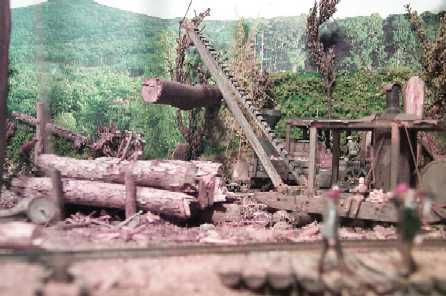 On the other side of the Spar
tree is a steam powered A frame loader which swings logs from the log deck onto
the tiny disconnect cars. This single drum beast was scratchbuilt around the
same time as the WIW yarder, and features many similar construction methods
and materials. It was built as a mixture of a few plans, and thus follows NKP,
(No Known Prototype). This unit is also removable for transport, and it alternates
with another loader at exhibitions. Note the activity in this scene, the two
loggers moving logs with peaveys and turners, and the two track workers passing
each other on the footbridge. Details such as these help to tell the story of
a small tramway, and really grab people's attention.
On the other side of the Spar
tree is a steam powered A frame loader which swings logs from the log deck onto
the tiny disconnect cars. This single drum beast was scratchbuilt around the
same time as the WIW yarder, and features many similar construction methods
and materials. It was built as a mixture of a few plans, and thus follows NKP,
(No Known Prototype). This unit is also removable for transport, and it alternates
with another loader at exhibitions. Note the activity in this scene, the two
loggers moving logs with peaveys and turners, and the two track workers passing
each other on the footbridge. Details such as these help to tell the story of
a small tramway, and really grab people's attention.
The log deck and footbridge were both very simple models, formed as they would have been on the prototype. Obtain twigs (or branches) of appropriate diameter, split the straightest sections into half round "flitches", and build the structures then and there on-site.
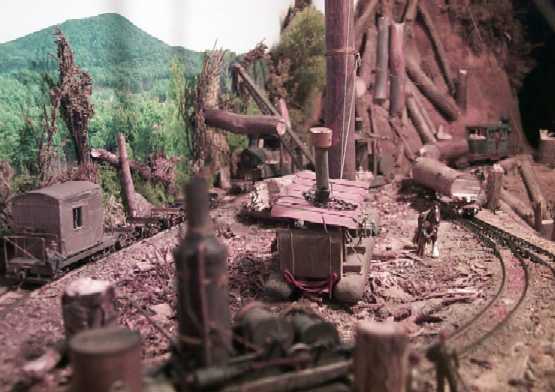 This
shot is a bit of an anomaly, in the sense that very few people will actually
ever get to see it. This shot required aiming the camera over the "Blunt"
or blank end of the layout, and it is this side which is usually backed up against
a wall at exhibitions. The Climax and loaded discon log cars snaking their way
through the log loading area at Woodhill Mountain downgrade towards Broughton
Vale echoes the ambience of the Australian bush logging industry we originally
set out to capture. Small machines, on small tracks, hauling big timber.
This
shot is a bit of an anomaly, in the sense that very few people will actually
ever get to see it. This shot required aiming the camera over the "Blunt"
or blank end of the layout, and it is this side which is usually backed up against
a wall at exhibitions. The Climax and loaded discon log cars snaking their way
through the log loading area at Woodhill Mountain downgrade towards Broughton
Vale echoes the ambience of the Australian bush logging industry we originally
set out to capture. Small machines, on small tracks, hauling big timber.